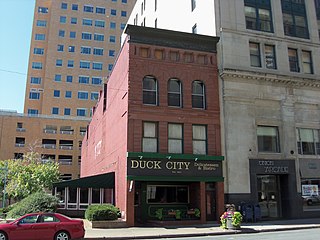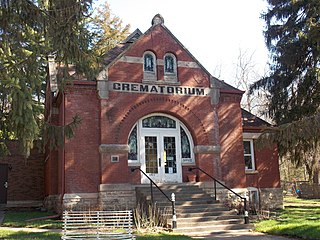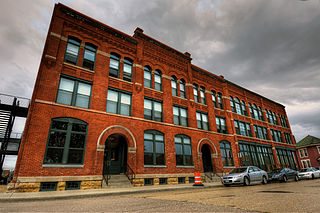
The Thomas C. Carson House is a historic building located in Iowa City, Iowa, United States. It is currently in use as the sorority house of the University of Iowa chapter of Alpha Phi, and is thus also known as the Carson-Alpha Phi House.

The Nicholas J. Kuhnen House is a historic building located in central Davenport, Iowa, United States. It has been listed on the National Register of Historic Places since 1983.

Hillside, also known as the Charles Schuler House, is a mansion overlooking the Mississippi River on the east side of Davenport, Iowa, United States. It has been individually listed on the National Register of Historic Places since 1982, and on the Davenport Register of Historic Properties since 1992. In 1984 it was included as a contributing property in the Prospect Park Historic District.

The Schmidt Block , also known as the F.T. Schmidt Building, is a historic building located in downtown Davenport, Iowa, United States. It was individually listed on the National Register of Historic Places in 1983. In 2020 it was included as a contributing property in the Davenport Downtown Commercial Historic District.

The Louis P. and Clara K. Best Residence and Auto House, also known as Grandview Apartments and The Alamo, is a historic building located in the central part of Davenport, Iowa, United States. It was included as a contributing property in the Hamburg Historic District in 1983, and it was individually listed on the National Register of Historic Places in 2010.

The Davenport Crematorium is located in Fairmount Cemetery in the West End of Davenport, Iowa, United States. It was the first crematorium established in the state of Iowa and one of the oldest in the United States. The facility was listed on the National Register of Historic Places in 1983.

The Ball–Waterman House is a historic building located on the eastside of Davenport, Iowa, United States. It has been listed on the National Register of Historic Places since 1984.

The Gustov C. Lerch House is a historic building located in the West End of Davenport, Iowa, United States. It has been listed on the National Register of Historic Places since 1983.

The John Littig House is a historic building located on the northwest side of Davenport, Iowa, United States. The Gothic Revival style residence was built in 1867 and has been listed on the National Register of Historic Places since 1984 and on the Davenport Register of Historic Properties since 1993.

Washington Gardens is a historic building located in the West End of Davenport, Iowa, United States. It has been listed on the National Register of Historic Places since 1984.

The Mahaska County Courthouse located in Oskaloosa, Iowa, United States, was built in 1886. It was individually listed on the National Register of Historic Places in 1981 as a part of the County Courthouses in Iowa Thematic Resource. In 1986 it was included as a contributing property in the Oskaloosa City Square Commercial Historic District. The courthouse is the second building the county has used for court functions and county administration.

The Osceola County Courthouse in Sibley, Iowa, United States, was built in 1902. It was listed on the National Register of Historic Places in 1981 as a part of the County Courthouses in Iowa Thematic Resource. The courthouse is the second building the county has used for court functions and county administration.

The E. H. Harrison House is a historic building located in Keokuk, Iowa, United States. It was designed in a combination of Federal, Greek Revival, and Second Empire styles by local architect Frederick H. Moore, and built in 1857 by local builder R.P. Gray. It is believed that this is the first house in Iowa to have a Mansard roof, which is its Second Empire influence. The Federal style is found in the building's large windows, the elliptical doorway arch, the bowed two story front bay, and the brickwork. The Greek Revival style is found in the offset doorway. Its interior features a unique open, two-story, self-supporting staircase that is said to be one of seven in existence in the United States. Additions have been built onto the back of the house, but their dates are unknown.

The Emma J. Harvat and Mary E. Stach House, also known as the De Saint Victor House, was the home of Emma J. Harvat, who was the first female mayor of Iowa City, Iowa and the first female leader of a U.S. city with a population greater than 10,000. Harvat was a successful businesswoman who had become financially independent and retired to Iowa City at the age of 43. After arriving there she became partner in another business venture with Mary (May) Stach, establishing Harvat and Stach to sell women's clothing. Harvat and Stach had the house on Davenport Street built for them in 1919. The house was designed by Iowa City architect Orville H. Carpenter, incorporating a variety of historical revival styles, dominated by Colonial Revival.

The Walter A. Sheaffer House, also known as the Craig & Margaret Abolt House, is a historic residence located in Fort Madison, Iowa, United States. It was listed on the National Register of Historic Places in 2006. The listing includes two structures, the main house and the garage cottage.

The George H. and Alice Spaulding Cowles House is a historic building located in Osceola, Iowa, United States. George Cowles was a native of Bentonsport, Iowa who came to Osceola in 1869, and married Alice Spaulding in 1871. He was a banker. The house was also owned by a local physician and his wife, Dr. Jason and Mary F.Q. Roberts. It is an example of a high style, architect-designed Italianate residence. Its architect, however, is unknown. The two-story brick structure follows a rectangular plan, and is capped with a hipped roof and a cupola. It features shallow side wings, single story bays, porches on the front and sides of the structure, small gabled dormers at the roof line on the front and side elevations, and two large brick chimneys with decorative brick venting caps. The house was listed on the National Register of Historic Places in 2006.

The Andrew–Ryan House is a historic house located in Dubuque, Iowa, United States. This is considered the best example of the Second Empire style in the city, and one of finest in the state of Iowa. The two-story brick structure was designed by Dubuque architect Fridolin J. Herr Sr. It was originally built 13 feet (4.0 m) to the north, but was moved to its present location between 1885 and 1890. The porches on the south side may have been added at that time. The house is from the high Second Empire style and features a mansard roof, arched windows, dominant chimneys, a prominent belvedere, and classical moldings on the pilasters, belt courses, and stone work.

The Letovsky-Rohret House is a historic building located in Iowa City, Iowa, United States. This simple two-story wood-frame structure largely embodies the Greek Revival style with its side gable roof, entablature window and door heads, boxed cornice and plain frieze, and its pedimented attic vents. The tall windows on the first floor and arched windows on the main door reflect elements of the Italianate style. Built in 1881, the house originally faced Van Buren Street, but it was turned to face Davenport Street in 1919 and placed on the eastern end of its lot so two more house could be built there.

The Gilbert-Linn Street Historic District is a nationally recognized historic district located in Iowa City, Iowa, United States. It was listed on the National Register of Historic Places in 2005. At the time of its nomination it consisted of 120 resources, which included 94 contributing buildings and 26 non-contributing buildings. This section of the city was developed as the population increased in the late 19th and early 20th centuries. The growth was due, in part, to the expansion of the University of Iowa and its hospitals. There was also an expansion of the central business district at the same time. Both professionals and business owners built houses here. The district contains houses for the upper class and the middle class, side by side to each other. It was also the place where German and Bohemian immigrant families resided.

Schroeder-Klein Grocery Company Warehouse, also known as the Shields & Bradley Block, is a historic building located in Dubuque, Iowa, United States. It was built to house the warehouse needs of the Schroeder-Kleine Grocer Company and the M.M. Walker Company, two of the most prominent wholesale food distributors in the upper Midwest at the turn of the 20th century. Local builders Shields & Bradley constructed the three-story warehouse in 1894 so that the two firms could operate independent of each other. When the two firms merged in 1921, the building became fully interconnected. It was used as a food distribution warehouse until 1959. Other commercial ventures that have been housed here have included beer and soda bottling and distribution, chemical production, overhead door sales, hair products retailer, and pet groomer.






















